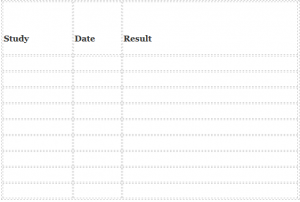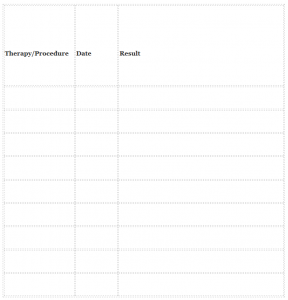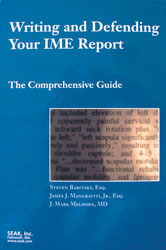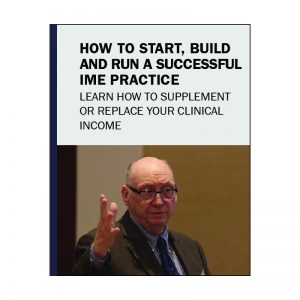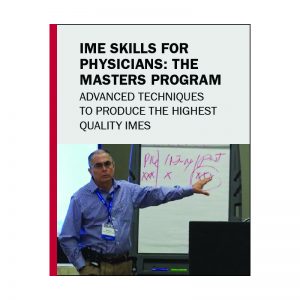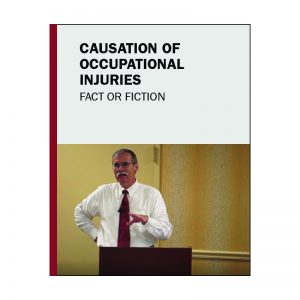The below can be used as a starting point to organize your IME report. This model IME report was established many years ago my Christopher R. Brigham, MD, a national thought leader in the field on IMEs. Versions of this standardized IME report format are used widely by students of Dr. Brigham.
Examinee: > [firstname] [lastname] Identification Number: >
Date of Examination: >
Examining Physician: >
Examination Location: >
Date of Birth: >
Date of Injury: >
Client Organization: >
Referral Source: >
Examinee’s Attorney: >
_______________________________________________________________________________________________________________________________________
Introduction
This >-year-old, >-handed wo/man was referred for an independent medical evaluation (IME) by the above client. The independent medical examination process was explained to the examinee, and s/he understands that no patient/treating physician relationship was established. Mr/s. was advised that the information provided will not be confidential and a report will be sent to the requesting client.
Mr/s. arrived at >, the interview commenced at >, followed by the physical examination, which started at > and was completed by >. Mr/s. was > cooperative. History was provided by the examinee who was a > historian. The information s/he provided was > consistent with the medical records provided.
A questionnaire and pain inventories were completed by the examinee. To ensure accuracy, the clinical history was dictated in his/her presence.
A staff member, >, was present throughout the physical examination. Mr/s. reported no difficulties occurring during the examination.
[Accompanying Mr/s. was > who >.]
The client provided the following clinical records: >.
These records were carefully reviewed. No records prior to >, or subsequent to >, were available for review. The following records were not available for review at the time of this examination and the preparation of this report: >
_______________________________________________________________________________________________________________________________________
History
Pre-Existing Status
S/he denies any previous problems or injuries, including any other work- or liability-related injuries.
Mr/s. also denies having any difficulties similar to those s/he is now experiencing until the injury.
Injury
S/he reports that on >.
At that time the difficulties were >.
Following the injury, s/he >.
Clinical Chronology
>.
Summary
Diagnostic Studies
Therapeutic Interventions
Current Status
The examinee’s chief complaint is >.
S/he reports difficulties with pain that is primarily located in the >. The pain is described as >. The pain is worsened by > and improved by >. The pain is reported as >.
On a scale from 0 (no pain) to 10 (excruciating pain), the examinee reports the pain now is a >. During the past month the pain averaged >, with a high of > and a low of >.
The examinee also reports difficulties with >.
Functional Status
S/he reports greatest difficulties with the following tasks: >.
Occupational History
At the time of the injury/s s/he had been employed by > and had been working there for >. S/he was working full time as a >. According to the description provided by the examinee, the job involved >. S/he has previously worked as a >. S/he has a > education.
In terms of current work status, s/he >. S/he reports work restrictions that include: >.
Social History
The examinee lives in >, with >. The activities of a typical day include >. S/he denies performing any other work activities or vigorous recreational pursuits.
The examinee >. S/he reports consuming > in a week.
Past Medical History
Medical: >
Surgery: >
Medications: >
Allergies: >
Review of Systems
Noncontributory
Family History
Noncontributory
_______________________________________________________________________________________________________________________________________
Physical Examination
Observations
The examinee is a >, > fe/male. S/he appears >. Examination of the hands reveals > callus. > assistive devices were used. Weight was > as > pounds and height was > as > feet > inches.
Behavioral Observations
The examinee was >. Affect was >. During the visit s/he appeared >. S/he sat continuously for up to > minutes during the interview. Pain behavior was noted, including >. Nonphysiologic findings were > present.
Structural Examination
In the standing neutral position cervical, thoracic, and lumbar curves were >. Extremities appeared >.
The shoulders were > and the pelvis was >. Gait was >.
Examination focused on the >.
Regional Examination
Observations
There was >.
Range of Motion
Range of motion was >. The following measurements were obtained: >.
Palpation
Tenderness was reported over the >.
Objective Findings
Positive physical findings included >.
Neurological Examination
Motor, sensory, and deep tendon reflexes were >.
Nonphysiological Examination
>.
_______________________________________________________________________________________________________________________________________
Diagnostic Studies
_______________________________________________________________________________________________________________________________________
Pain Status Inventories
Pain Drawing
The examinee completed a pain drawing (attached), using symbols to describe sensations. This drawing did > reveal findings suggestive of symptom magnification.
Pain Disability Index
The Pain Disability Index uses rating scales to measure the extent of perceived disability in seven areas of life. The results are as follows:
Area Perceived Disability
Family/home responsibilities >%
Recreation >%
Social activity >%
Occupation >%
Sexual activity >%
Self-care >%
Life-support activities >%
The total score is > out of a possible 70, for a total index of > %.
Oswestry Function Test
The score on the Oswestry Function Test was > out of a possible >, giving >%, indicating a perception of >.
Short-Form McGill Pain Questionnaire
The McGill Pain Questionnaire specifies fifteen potential pain descriptors. The examinee rates the intensity of each descriptor on a scale of 0 to 3. The total of all descriptors was >, the total of the eleven somatic descriptors was >, averaging >, and the total of the four affective descriptors was >, averaging >.
CES-D
The Center for Epidemiologic Studies Depressed Mood Scale was administered. The examinee scored >, which > consistent with a depressed mood.
_______________________________________________________________________________________________________________________________________
Conclusions
Diagnoses
1.
2.
3.
4.
5.
The subjective complaints are > consistent with the objective findings. Symptom magnification behavior was > evident.
Causation
Based upon the available information, to a reasonable degree of medical certainty, there is > causal relationship between the examinee’s current complaints and the reported injury.
Prognosis
The overall prognosis is >.
Maximum Medical Improvement
The examinee has > achieved maximum medical improvement. MMI is defined as the date after which further recovery and restoration of function can no longer be anticipated, based upon a reasonable degree of medical probability.
Permanent Impairment Evaluation
Permanent impairment evaluation was performed in accordance with the AMA’s Guides to the Evaluation of Permanent Impairment, > Edition. >.
Work Capacity
This examinee has at least a > work capacity as defined in the Dictionary of Occupational Titles, U.S. Department of Labor. >.
Appropriateness of Care
The client has asked that I specifically address the issue of appropriateness of medical care. Based on the specifics of this care, it is my professional opinion that care has > been consistent with the usual standards of care for this problem.
Recommendations
Diagnostic/Consultation
> further diagnostic testing or consultation is indicated.
Therapeutic
> further treatment is required.
The above analysis is based upon the available information at this time, including the history given by the examinee, the medical records and tests provided, the results of pain status inventories, and the physical findings. It is assumed that the information provided to me is correct. If more information becomes available at a later date, an additional report may be requested. Such information may or may not change the opinions rendered in this evaluation.
The examiner’s opinions are based upon reasonable medical certainty and are impartial. Medicine is both an art and a science, and although an individual may appear to be fit for work activity, there is no guarantee that the person will not be reinjured or suffer additional injury. If applicable, employers should follow the processes established in the Americans with Disabilities Act, Title I. The opinions on work capacity are to facilitate job placement and do not necessarily reflect an in-depth direct threat analysis. Comments on appropriateness of care are professional opinions based upon the specifics of the case and should not be generalized, nor necessarily be considered supportive or critical of, the involved providers or disciplines.
Any medical recommendations offered are provided as guidance and not as medical orders. The opinions expressed do not constitute a recommendation that specific claims or administrative action be made or enforced.
Thank you for asking me to see this examinee in consultation. If you have any further questions, please do not hesitate to contact me.
Sincerely,
If you are interested in learning how to write excellent IME Reports, we recommend the text; Writing and Defending Your IME Report
Best Selling Products for IME Providers
How to Start, Build and Run a Successful IME Practice
[Stream On-Demand]
IME Skills for Physicians: The Master’s Program
[Stream On-Demand]
How To Market & Grow Your IME Practice
[Stream On-Demand]
Causation of Occupational Injuries: Fact or Fiction
[Stream On-Demand]

